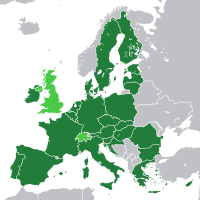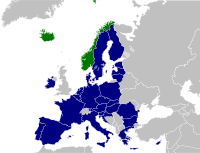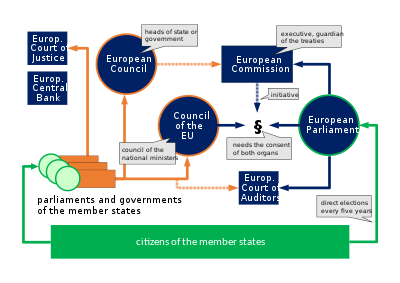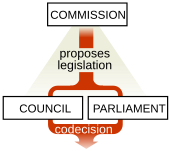Politics of the European Union
The EU treaties declare the Union to be based on representative democracy, and direct elections take place in the European Parliament.
Although direct elections take place every five years, there are no cohesive political parties in the national sense.
The latter was a significant political force in the United Kingdom in the decades and years before leaving the Union, and some member states are less integrated than others due to legal opt-outs.
The move toward unification first arose in the Kellogg-Briand Pact in 1928, which gained adherent countries during negotiations and took on a theme of integration for the achievement of peace between the Great Powers.
[1] After the Second World War, European society sought to end conflict permanently between states, seeing the rivalry between France and Germany as the most worrying example.
The various additions and modifications of treaties has led to a patchwork of policy and planning, which contributes to the unwieldiness of the EU.
The pastiche of treaties, and not a single actualising charter of government, form the constitutional basis of the European Union.
Yet in those areas where the EU has been granted competences, it does have the power to pass binding and direct laws upon its members.
The competences of the European Union stem from the original Coal and Steel Community, which had as its goal an integrated market.
The original competences were regulatory in nature, restricted to matters of maintaining a healthy business environment.
The size of the bureaucracies increased, requiring modifications to the treaty system as the scope of competences integrated more and more functions.
While member states hold their sovereignty inviolate, they remain within a system to which they have delegated the tasks of managing the marketplace.
These tasks have expanded to include the competences of free movement of persons, employment, transportation, and environmental regulation.
The co-decision rule in Maastricht, and the subsequent Lisbon Treaty, ultimately gave the EP and the Council equal weight and formalised OLP as the main legislative procedure.
Directives are binding on all member states, but the implementation is left up to the national courts in a process called transposition.
In exchange for conferring competences, EU states are assigned votes in the Council, seats in Parliament and a European Commissioner among other things.
The committee is composed of the Council members plus an equal number of MEPs who seek to agree a common position.
[12] The European Commission is composed of one appointee from each state, currently twenty-seven, but is designed to be independent of national interests.
The council's adoption of the commission is not an area which requires the decision to be unanimous, their acceptance is arrived at according to the rules for qualified majority voting.
Parliament's elections are held by universal suffrage of EU citizens according to national restrictions (such as age and criminal convictions).
The turnout was steadily falling in every EU election since 1979, until 2019, where it increased 8 pp from 42.6% to 50.7%, and then again in 2024 by 0.39 pp to 51.05%[16] As of 2024, Bulgaria's (GERB, Croatia's (HDZ), Cyprus (DISY), Germany's (CDU/CSU), Hungary's (Fidesz), Malta's (Labour Party) and Sweden (Swedish Social Democratic have won every EU election.
[21] UK Prime Minister Tony Blair agreed to review the British rebate, negotiated by Margaret Thatcher in 1984.
[22] Controversial issues during budget debates include the British rebate, France's benefits from the Common Agricultural Policy, Germany and the Netherlands' large contributions to the EU budget, reform of the European Regional Development Funds, and the question of whether the European Parliament should continue to meet both in Brussels and Strasbourg.
The constitution was rejected by France and the Netherlands, where referendums were held[23] causing other countries to postpone or halt their ratification procedures.
[24][25] "Counter-nationalistic shearing stress" is the term coined by one commentator for the theoretical tendency of certain regions of larger countries of the EU to wish to become fully independent members within the wider context of the European Union's "bigger umbrella".
If the Union is to become "ever closer", it follows that regions with their own distinctive histories and identities within the existing member nations may see little reason to have a layer of "insulation" between themselves and the EU.









|
91–100%
81–90%
71–80%
|
61–70%
51–60%
|